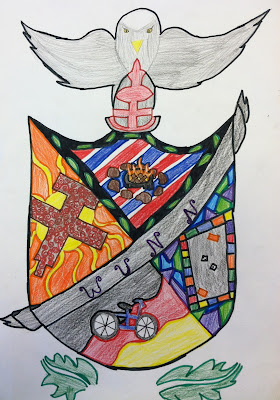I Mustache You A Question...
Do you know Salvador Dali? And more importantly, do you know about his 'stache?
Fourth graders started off the art year learning about the craziness that is Surrealism and the ever so eccentric, Salvador Dali. We learned about him and some of his quirky behaviors (did you know he was terrified of grasshoppers?), the qualities of Surrealism and about his infamous mustache! I introduced all of this to them with a PowerPoint (if you want a copy of it for your classroom, just ask, I can send it your way).
This lesson focuses on Art History with Salvador Dali and Surrealism but I also take it as an opportunity to teach about portraiture and facial proportions. Since we focus on the silliness of Surrealism and the silliness of Salvador's mustache, I give the kids the option to wear fake mustaches while they work...this really adds a lot of fun to the lesson and a hilariously awesome work environment.
We discuss facial structure as a class and I have the students draw a nice and large portrait (it can be of Salvador Dali, themselves, or someone else--even a made up person). We then discuss background and foreground overlapping and add a surreal background that is inspired by Dali. The students used watercolor to paint their portrait and background and then came the fun part...the mustache! When the students are done painting, they are given a pipe cleaner to bend into any strange mustache shape they would like. And when their painting is dry, I personally hot glue it onto their portrait for them. Some kids still like to readjust their mustache after the hot glue dries, but for the most part, the kids are pleased with their creation! This is, by far, one of my favorite lessons! I just love the atmosphere of the kids wearing fake glasses and mustaches and then, when the artwork is finished and hung, having 75 silly mustachioed portraits greet me as I walk down the halls (pictured below)!
When/if students finish early, I like to offer a supplemental activity that is in theme or reiterates what we were learning. So for the Surrealism aspect of this lesson, I asked students who finished early to make up their own animal and they had a blast with it! There are some really creative minds out there and they didn't even just stop with their drawing, a lot of them came up with names for their animals (ever see a turtlope?)
More 'staches from other years:
This lesson focuses on Art History with Salvador Dali and Surrealism but I also take it as an opportunity to teach about portraiture and facial proportions. Since we focus on the silliness of Surrealism and the silliness of Salvador's mustache, I give the kids the option to wear fake mustaches while they work...this really adds a lot of fun to the lesson and a hilariously awesome work environment.
We discuss facial structure as a class and I have the students draw a nice and large portrait (it can be of Salvador Dali, themselves, or someone else--even a made up person). We then discuss background and foreground overlapping and add a surreal background that is inspired by Dali. The students used watercolor to paint their portrait and background and then came the fun part...the mustache! When the students are done painting, they are given a pipe cleaner to bend into any strange mustache shape they would like. And when their painting is dry, I personally hot glue it onto their portrait for them. Some kids still like to readjust their mustache after the hot glue dries, but for the most part, the kids are pleased with their creation! This is, by far, one of my favorite lessons! I just love the atmosphere of the kids wearing fake glasses and mustaches and then, when the artwork is finished and hung, having 75 silly mustachioed portraits greet me as I walk down the halls (pictured below)!
When/if students finish early, I like to offer a supplemental activity that is in theme or reiterates what we were learning. So for the Surrealism aspect of this lesson, I asked students who finished early to make up their own animal and they had a blast with it! There are some really creative minds out there and they didn't even just stop with their drawing, a lot of them came up with names for their animals (ever see a turtlope?)
.JPG) |
| We made a small list of what we remembered about Surrealism in our second class period together. Then I showed them how to use their finished early time by inventing their own animal! |
.JPG) |
| Take note that this student wrote "Made in 1982" at the bottom...must be a vintage animal |








.JPG)
.JPG)
.JPG)

.JPG)
.JPG)
.JPG)





.JPG)
.JPG)
.JPG)
.JPG)

.JPG)















